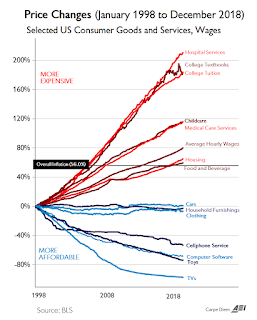Summary:
Is inflation much higher than the official figures suggest? Jesse Colombo seems to think so, who says they are closer to 10% rather than the officially stated 2%. And much of the inflation is being hidden in asset bubbles, he says, and will burst eventually. One of the primary ways that our modern CPI formula understates inflation is through hedonic quality adjustments. In simple terms, consumer goods that experience technological improvements are considered to have fallen in price when calculating the CPI even if the price has stayed the same or even increased in real life. For example, if a computer with an eight-core processor costs ,000 today and most computers have sixteen-core processors but cost ,300 in two years from now, it may get recorded as only costing 0 for
Topics:
Mike Norman considers the following as important:
This could be interesting, too:
Is inflation much higher than the official figures suggest? Jesse Colombo seems to think so, who says they are closer to 10% rather than the officially stated 2%. And much of the inflation is being hidden in asset bubbles, he says, and will burst eventually. One of the primary ways that our modern CPI formula understates inflation is through hedonic quality adjustments. In simple terms, consumer goods that experience technological improvements are considered to have fallen in price when calculating the CPI even if the price has stayed the same or even increased in real life. For example, if a computer with an eight-core processor costs ,000 today and most computers have sixteen-core processors but cost ,300 in two years from now, it may get recorded as only costing 0 for
Topics:
Mike Norman considers the following as important:
This could be interesting, too:
Robert Vienneau writes Austrian Capital Theory And Triple-Switching In The Corn-Tractor Model
Mike Norman writes The Accursed Tariffs — NeilW
Mike Norman writes IRS has agreed to share migrants’ tax information with ICE
Mike Norman writes Trump’s “Liberation Day”: Another PR Gag, or Global Reorientation Turning Point? — Simplicius
Is inflation much higher than the official figures suggest? Jesse Colombo seems to think so, who says they are closer to 10% rather than the officially stated 2%. And much of the inflation is being hidden in asset bubbles, he says, and will burst eventually.
One of the primary ways that our modern CPI formula understates inflation is through hedonic quality adjustments. In simple terms, consumer goods that experience technological improvements are considered to have fallen in price when calculating the CPI even if the price has stayed the same or even increased in real life. For example, if a computer with an eight-core processor costs $1,000 today and most computers have sixteen-core processors but cost $1,300 in two years from now, it may get recorded as only costing $800 for the purpose of calculating the CPI. Of course, that’s no consolation to the consumer who actually has to pay $1,300.
Because so many high-tech consumer products have entered our lives over the past forty years and those products have improved at a rapid rate, they have masked the very real inflation that has occurred in big ticket necessities like housing, healthcare, childcare, and higher education. Sure, it’s great that laptops, cell phones, and big screen TVs have been falling in price while gaining more features, but that doesn’t help Americans who are going bankrupt due to exorbitant medical bills, being crushed under the weight of student loans, and can’t find affordable housing anywhere.
The chart below from the American Enterprise Institute shows the dichotomy between high-tech consumer products, which have been falling in price, and big ticket necessities that have surged in price and are becoming increasingly out of reach for many Americans:

